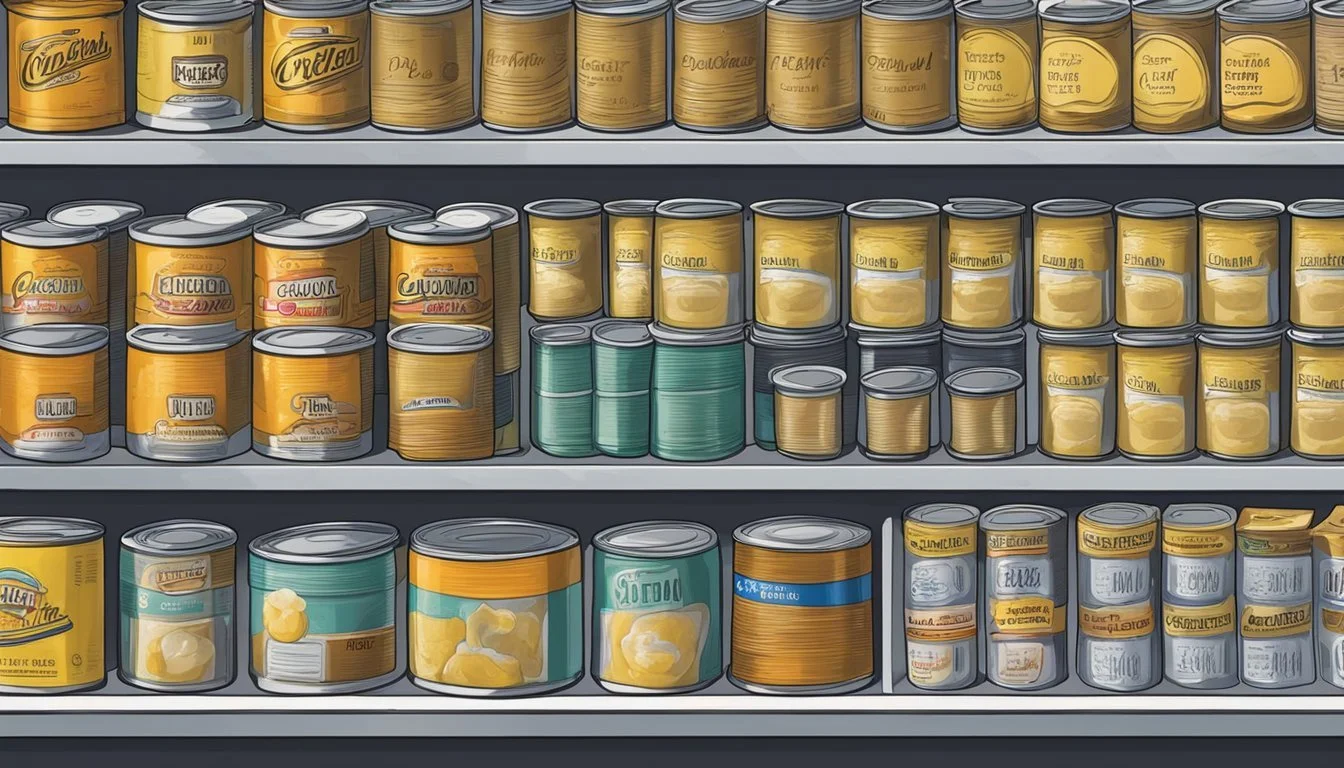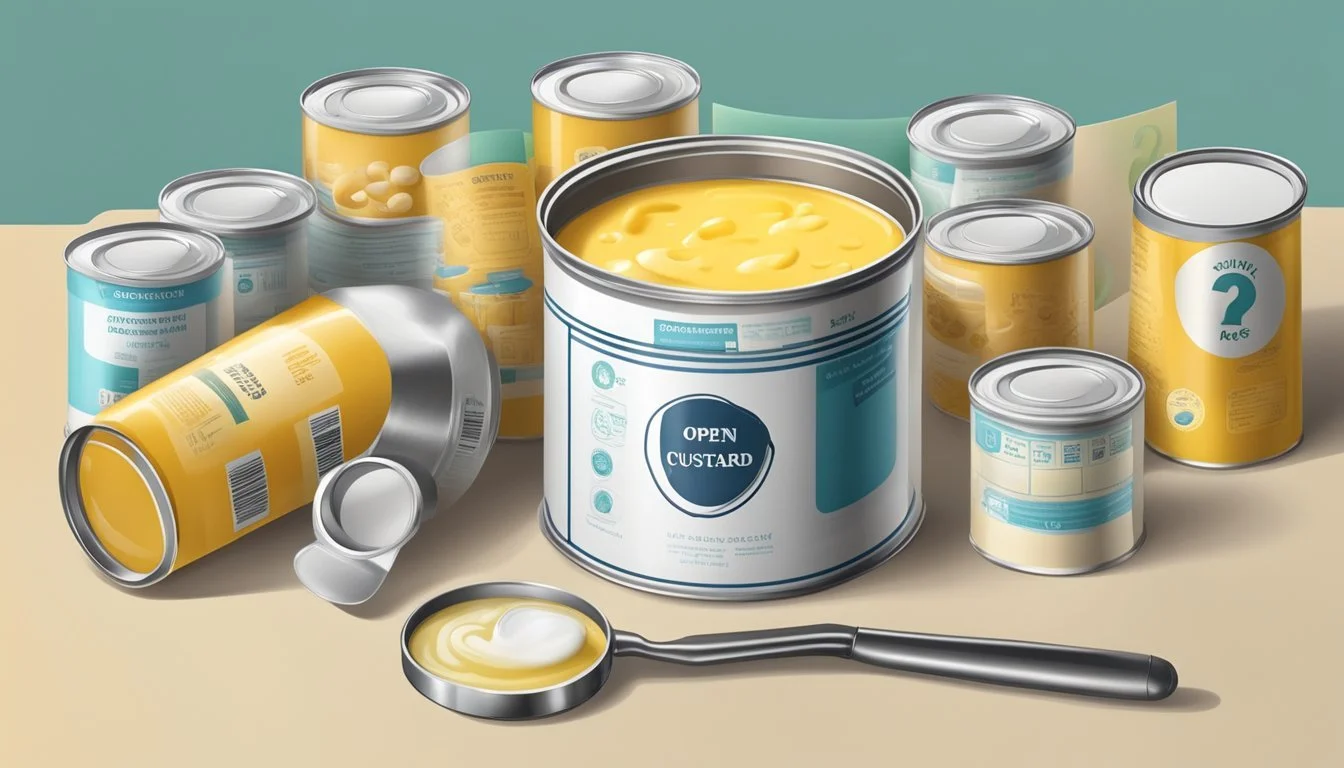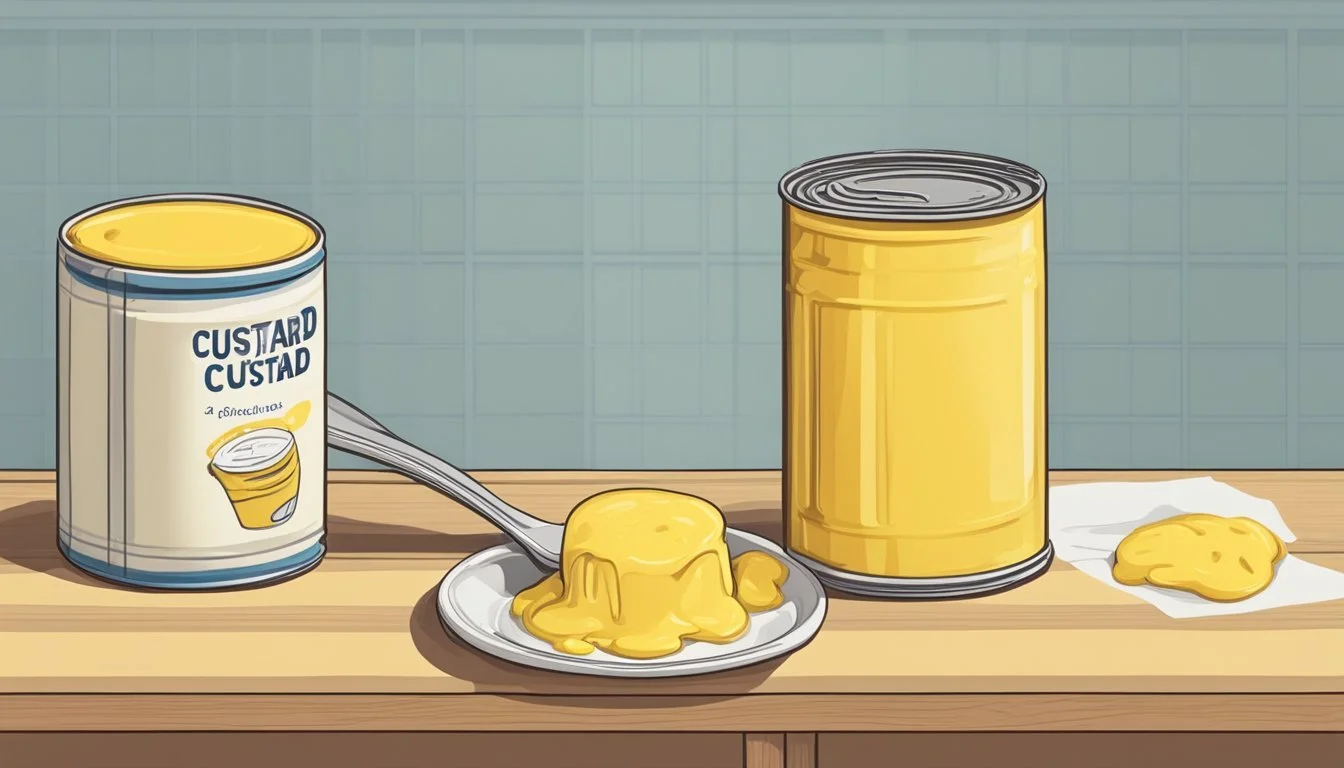Does Canned Custard Expire?
Shelf Life and Storage Tips
Canned custard is a popular convenience food, offering a quick and easy dessert option. Many people wonder if canned custard expires and how long they can safely store it. The shelf life of canned custard can vary, but typically, it can last for several years past the printed expiration date if stored in proper conditions.
The key to prolonging the shelf life of canned custard lies in keeping the cans in a cool, dry place away from direct sunlight. High acid foods, like custard, are often more susceptible to changes in flavor and texture over time. It's important to check the integrity of the can before consuming.
Consumers should always look for signs of spoilage, such as bulging cans, rust, or an unusual odor when opened. By following these guidelines, they can enjoy the convenience and taste of canned custard safely.
Understanding Food Expiration Labels
Understanding food expiration labels is essential for determining the safety and quality of products like canned custard. These labels include expiration dates, sell-by dates, and use-by dates, each serving different purposes.
Expiration Date vs Sell-By Date vs Use-By Date
Expiration Dates typically indicate the last date a food product is expected to maintain its peak quality and flavor. This is particularly important for items like canned custard, where texture and taste can degrade over time. It is not a strict safety guideline but rather a quality assurance measure.
Sell-By Dates are mainly for retailers, guiding them on how long to display a product for sale. After this date, the food might still be safe to consume but may not be at its best quality. Consumers should consider sell-by dates when purchasing but focus more on storage conditions at home.
Use-By Dates are the most critical for food safety. This date marks the end of the period when the product is expected to be at its best in terms of quality and safety. For perishable items, following the use-by date is crucial to avoid potential health risks.
How Manufacturers Determine Shelf Life
Manufacturers use several methods to establish the shelf life of products like canned custard.
First, they conduct laboratory tests to evaluate how the ingredients interact over time. These tests might include assessing microbiological stability, chemical changes, and physical alterations such as separation or discoloration.
Second, sensory evaluations are performed where experts taste and smell the product at various stages. Based on these evaluations, they estimate the period during which the product will maintain its intended flavor, texture, and aroma.
Third, storage condition simulations are run to see how different environments impact shelf life. This includes varying temperatures, humidity levels, and light exposure. Each of these factors contributes to the final determination of the expiration, sell-by, and use-by dates provided on labels.
The Science of Canned Foods
Canned foods are known for their long shelf life, which is a result of specific preservation techniques. Understanding the canning process and the role of acidity in food preservation is crucial for assessing canned food safety and quality.
Canning Process and Preservation
The canning process involves sealing food in airtight containers and subjecting them to heat. This pasteurization step destroys harmful microorganisms and inactivates enzymes that could cause spoilage.
A key element is the vacuum seal, which prevents air from entering and further contamination. By creating a shelf-stable product, canning extends the food's usability significantly.
Foods like soups, vegetables, and meats undergo varying degrees of processing depending on their makeup. High-temperature processes ensure that even low-acid foods remain safe to consume for extended periods, reducing the risk of botulism.
High-Acid and Low-Acid Foods
High-acid foods, such as tomatoes and fruits, have a pH below 4.6. This acidity hinders the growth of harmful bacteria and often requires less intense heat treatment. These foods can be safely preserved with milder pasteurization techniques.
In contrast, low-acid foods like meats, poultry, and most vegetables have a pH above 4.6 and are more susceptible to bacterial contamination. These require more rigorous heat treatment to ensure safety. The processing for low-acid foods must reach higher temperatures to eliminate the risk of botulism.
Understanding the balance between acidity and heat processing allows consumers to gauge the safety and longevity of different canned foods. This knowledge is crucial, particularly when evaluating the edibility of items past their "best by" dates.
Shelf Life of Canned Custard
Canned custard offers a convenient way to enjoy this creamy dessert without the immediate concerns of perishability. Understanding the differences between keeping it unopened and opened can help maintain its quality and safety.
Opened vs Unopened Cans
Unopened canned custard:
An unopened can of custard generally has a long shelf life, often lasting for up to a year or more.
Factors such as the brand and packaging quality impact shelf life. Always check the expiration date printed on the can.
Store in a cool, dry place to maximize longevity.
Opened canned custard:
Once opened, the custard must be refrigerated and should ideally be consumed within 3-4 days.
Use an airtight container to prevent exposure to moisture and bacteria.
Check for any off smells or tastes before consuming, as these are signs it may no longer be safe.
Indicators of Quality and Safety
Check the Expiration Date: Always start by verifying the expiry date on the label.
Visual Inspection: Look for changes in color or texture. Any separation, cloudiness, or mold indicates spoilage.
Smell Test: A sour or unusual odor is a clear sign the custard has gone bad.
Taste Test: If the custard tastes off or sour, it should be discarded immediately.
By paying attention to these indicators, you can ensure that your canned custard remains both tasty and safe to eat.
Proper Storage Techniques
Proper storage of canned custard is crucial for maintaining its quality, safety, and taste. Key factors include ideal pantry conditions, refrigeration after opening, and methods to extend shelf life.
Ideal Conditions for Pantry Storage
Canned custard should be stored in a cool, dry place away from direct sunlight. Optimal storage temperatures range between 50°F and 70°F (10°C - 21°C). Avoid areas with high humidity or drastic temperature changes, as these can compromise the can's integrity and, consequently, the custard's quality.
Ensure the cans are stored on a stable shelf without heavy items stacked on top. Too much weight can dent the cans, leading to potential breaches.
Refrigerating After Opening
Once opened, transfer the custard from the can to an airtight container to maintain freshness and prevent contamination. Store this container in the refrigerator at a temperature below 41°F (5°C).
Do not leave canned custard out at room temperature for extended periods, as this increases the risk of bacterial growth. Always check for any signs of spoilage, such as sour smell or an off taste, before consuming.
Extending Shelf Life
To extend the shelf life of canned custard, ensure it remains sealed and stored properly in the pantry until needed. For leftover custard, ensure the container used for refrigeration is airtight and appropriately sized to minimize air exposure, which can lead to spoilage.
Using a vacuum sealer for leftover custard can also help extend its shelf life by reducing oxygen exposure. Avoid freezing custard, as this can alter its texture and flavor upon thawing.
Proper attention to storage conditions, both before and after opening, can significantly impact the custard's longevity and quality.
Signs of Spoilage in Canned Custard
Identifying spoilage in canned custard involves looking for specific visual and sensory signals. Consuming spoiled custard poses health risks, making it essential to be vigilant about these indicators.
Visual and Sensory Clues
Detecting spoilage often starts with visual checks. Discoloration is a key sign—custard should have a consistent color, and any darkening or unusual spots suggest deterioration. Texture changes such as clumping or separation can also indicate spoilage.
Smell the custard. A sour or off odor points to bacterial activity and spoilage. Taste should be the last sensory check; any off or sour taste confirms spoilage and the custard should be discarded immediately.
Risks of Consuming Spoiled Products
Eating spoiled canned custard can lead to foodborne illnesses. Bacteria such as Salmonella or E. coli could be present, causing symptoms like stomach cramps, diarrhea, and fever.
Other microorganisms might produce toxins that are not destroyed by cooking. These toxins can lead to poisoning, which may require medical attention. Therefore, it's essential to check for the aforementioned visual and sensory clues to avoid these health risks.
Health and Safety Considerations
When discussing the shelf life of canned custard, it's essential to understand the factors that can contribute to spoilage as well as how to prevent food-borne illness.
Factors Contributing to Spoilage
Several factors can lead to the spoilage of canned custard. Temperature is crucial; exposure to high temperatures can cause the custard to spoil more quickly. Cans that are damaged or dented present risks by compromising the seal, allowing bacteria to enter.
Another significant factor is expiry dates. Although canned food can last beyond these dates, the quality and safety of the custard may degrade over time. Storage conditions also matter. Keeping cans in a cool, dry place ensures the custard's longevity.
Preventing Food Borne Illness
To prevent food-borne illnesses such as botulism caused by Clostridium botulinum, consumers should inspect cans for bulging or leaks. These are signs of bacterial activity. Proper handling is another preventive measure; always wash hands and kitchen tools before handling canned foods.
Avoiding cross-contamination is crucial. Use separate utensils for different food items and keep the custard airtight to avoid bacterial exposure. If there are any doubts about the condition of the canned custard, it's safest to discard it.
Understanding these key points can help ensure that canned custard remains safe and enjoyable for all consumers.
Impact on Nutrition and Taste
Canned custard, like many other canned foods, undergoes changes in both its nutritional value and its taste over time. These changes are subtle initially but can become more significant the longer the product is stored.
Nutritional Value Over Time
The nutritional content of canned custard can change over time but generally remains stable within the printed expiration date. Vitamins such as Vitamin A and Vitamin D may degrade slightly over extended periods.
Macronutrients like carbohydrates, fats, and proteins usually remain consistent. However, the minerals such as calcium and iron found in custard are stable and unlikely to degrade in sealed cans.
Storage conditions like temperature and humidity can also impact the nutritional value. Keeping the cans in a cool, dry place can help maintain its nutrition longer. Extended storage beyond its use-by date might not significantly impact macronutrients but can affect micronutrient levels.
Changes in Flavor and Texture
The flavor and texture of canned custard can alter after long-term storage. Upon initial manufacturing, the custard has a smooth texture and a rich, creamy flavor. Over time, the texture can become less smooth, sometimes developing a grainy or watery consistency.
The flavor may also become less pronounced. Fresh custard has a distinct sweet flavor, but this can dull over time. Changes in temperature and exposure to light can exacerbate these changes.
For the best taste experience, it’s advisable to consume the custard well within its printed expiration date while properly stored to retain as much of the original flavor and texture as possible.
Ethical and Environmental Considerations
Canned custard has a role in reducing food waste and promoting sustainable consumption practices among consumers and manufacturers.
Reducing Food Waste
The shelf-stability of canned custard makes it a valuable player in minimizing food waste. Unlike fresh custard, which spoils quickly, canned custard can be stored for extended periods without degrading, helping consumers avoid the waste associated with perishable goods.
Manufacturers benefit from the longer shelf life by reducing losses due to spoilage during transportation and storage. Proper labeling and clear expiration guidelines are crucial. They help consumers make informed decisions about the safety and usage of canned custard, thereby reducing unnecessary disposal of edible products.
Consumers should be educated about interpreting expiration dates and encouraged to use products close to their labeled expiration to minimize overall waste.
Sustainable Consumption Practices
Canned custard contributes to sustainable consumption practices when sourced and consumed responsibly. Opting for eco-friendly packaging, such as recyclable cans, can significantly reduce the environmental footprint of canned goods.
Consumers can support brands that emphasize sustainable practices in production and packaging. Reducing energy usage in the supply chain, from manufacturing to distribution, is critical for minimizing the environmental impact of canned custard production.
Promotion of bulk purchasing or multi-use packaging options can also encourage more sustainable consumption patterns. Community awareness campaigns can further educate on the environmental benefits of choosing shelf-stable, responsibly-produced items like canned custard.








